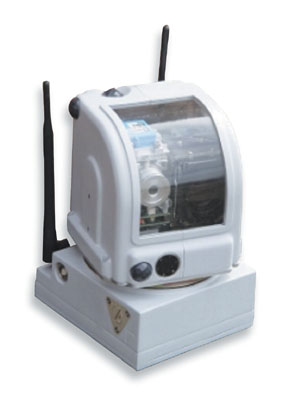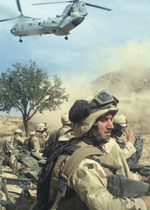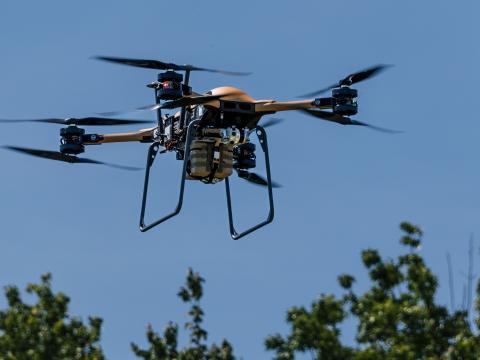Portable Sensors Extend Warriors' Reach
 |
| The Small Unit Sensor System (SUSS) is an effort by the U.S. Marine Corps Warfighting Laboratory to enhance the situational awareness of combat units. The system consists of video and infrared cameras housed in a case that can be carried in a specially designed backpack. A wireless link allows soldiers to safely monitor an area away from enemy fire. |
U.S. Marine Corps units soon may be equipped with manportable electro-optic sensors that will help augment security during operations. The devices form part of a prototype suite of automated reconnaissance systems that will permit warfighters to control more territory and to have better situational awareness.
The tactical necessity to see around the corner or over the next hill has driven the U.S. Defense Department to develop a variety of sensor platforms for troops to use in combat. One result of this work is the Small Units Sensor System (SUSS) program underway at the U.S. Marine Corps Warfighting Laboratory in
Launched in 2001, the SUSS is an effort to correct tactical deficiencies the Marine Corps identified during operations in asymmetric environments. A key requirement was the need for a small tactical reconnaissance, surveillance and target acquisition system for use by units at the company level and below.
According to 1st Lt. Greg Dunay, USMC, project officer for targeting, reconnaissance and acquisitions, Marine Corps Warfighting Laboratory, the service is moving toward a new doctrine known as distributed operations. This concept calls for Marine Corps formations to operate in smaller, more geographically dispersed units but to sustain their current ability to mass force and defend themselves. To achieve this vision, a variety of technologies will be necessary to maintain situational awareness and connectivity. Lt. Dunay notes that the SUSS program is just one idea for a sensor to augment a small unit’s capabilities.
One of the goals of the program is to provide Marine Corps units with the ability to deploy sensors that can cover difficult or dangerous areas. The devices also are intended to reduce manpower requirements while feeding real-time imagery to nearby troops.
The SUSS is a manportable, hand-emplaced electro-optic sensor. The initial SUSS prototype has three components: a sensor turret that can rotate 360 degrees, an operator control system (OCS) and a hand controller. The OCS and the hand controller are the same devices used with the Dragon Runner mobile ground sensor. The SUSS contains a miniature uncooled thermal imager, a miniature color zoom video camera, motion sensors, an acoustic sensor, infrared light emitting diodes and pan/tilt camera motion. The sensor also features a remote wireless link to the user. Each individual SUSS system weighs several pounds and is transported in a modular backpack. The backpacks are fitted with a hand controller, which combines camera pan/tilt functions with a small video screen, and wireless equipment.
Lt. Dunay explains that most of the technology in the SUSS—such as the cameras, their control systems and the wireless links—is commercially available. The sensors can be connected together into a network loop. Operators cannot see multiple screen images windowed on the hand controller screen, but they can switch quickly from one camera to another. Because it is still in the prototype stage, the technology will most likely undergo further improvements before a final version is issued to units in the field.
Today, the technology is focused on supporting small units at the company level or below. However, when its capabilities are fully tested under operational conditions, other niches may be found for the SUSS. The lieutenant explains that earlier versions of the sensor package have been tested, but he adds that two new SUSS prototypes were built and are scheduled for field tests in late March.
If these new systems successfully complete their tests, the laboratory will deploy them to
The SUSS is designed for ease of use, and the lieutenant is certain that Marines operating in
Because they can be operated remotely, SUSS sensors could perform a variety of duties, such as guarding a unit’s rear or flanks in an urban combat environment or enhancing perimeter security at night. “You don’t want to say that it takes the place of a person, but it is an extra set of eyes,” he shares.
 |
| The SUSS, part of a broader effort by the Marine Corps, is designed to allow units such as these Marines operating in Afghanistan to operate farther apart from each other but maintain their maneuver and combat capabilities. The sensor system will enable units at the company size and below to observe remotely and to protect their flanks or perimeters in asymmetric warfare environments such as urban and mountainous areas. |
The SUSS is envisioned as part of a suite of systems designed to support Marine Corps units. The laboratory is working on a modular wearable computer (MOWC) that will allow designated individuals in a squad or platoon to control a variety of devices such as the SUSS, Dragon Runner mobile sensors and Dragon Eye battalion-level unmanned aerial systems. The MOWC weighs less than 6 pounds and will be integrated into a Marine’s equipment. It consists of a central processing unit, a battery pack, a head-mounted display and an interface hub. Its components will allow the user to select and control any of the three tactical sensor systems.
As development proceeds, the SUSS and the wearable computer will merge into a single system, the lieutenant explains, because the MOWC uses the same wireless backpack and handheld camera controller as the SUSS pack. This would allow a user to control several different platforms from the computer rather than only a single sensor system.
Although the SUSS soon may be deployed to
Lt. Dunay believes that the MOWC would be issued to several soldiers in a squad or company who are designated to operate the unit’s sensors and unmanned systems. But he maintains that Marine Corps departments will determine the doctrine for the most efficient use of the technology. While the lieutenant does not believe Marines will require specialist training to use the MOWC, he speculates that a unit may have at least one designated individual operating the system. “It’s not going to be a system that you can just hand out to an untrained person and expect it to operate effectively,” he says.
Web Resource




Comments